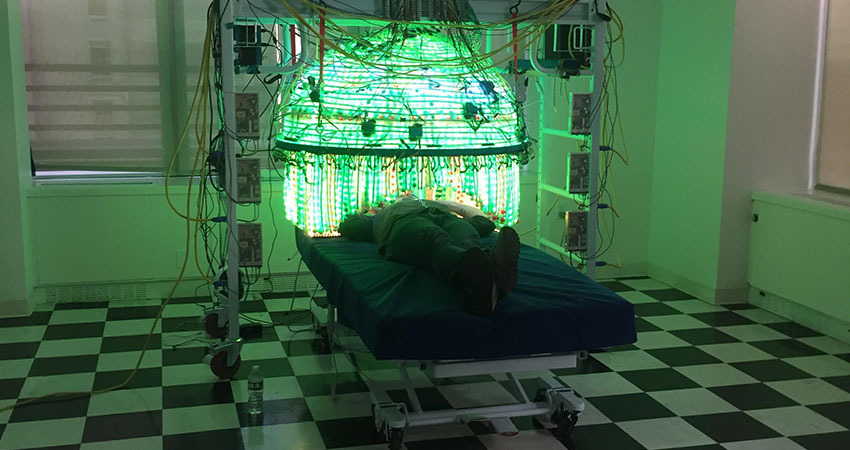Text by Charlotte Kent

Touching is an issue now. The elbow bumps, foot taps, nods, and bows of greeting at assorted events of the last couple of weeks make that clear. As coronavirus makes people ever leerier of touching each other––or each other’s phones, computers, and other devices––interactive art faces particular challenges.
Obviously, the most important thing in any healthcare crisis is medical care for those who need it. For the rest of us, minimizing the spread means increased attention to safety warnings and advice. Reduced contact with each other is foremost. Given that COVID-19 had been in the news with shut down of geographic areas and museums and fairs, it was surprising that galleries displaying interactive works have been so haphazard in their approach.
It’s not uncommon for wipes and sanitizing to be a part of a VR set-up and some interactive art, whether using screens or navigating physical objects across an installation. In the context of the media awareness of contagion, it was all the more peculiar to notice such wide-ranging responses across the various art fairs and galleries that I recently surveyed. Some had gloves and eye covers; others did not. Some provided hand sanitiser. Some handled the objects as they fitted audiences to the experience, while others kept their distance. None, by any standard, were adequate.
In this atmosphere, those working with interactive art need to become more sensitive to health concerns. Odd as it seems now, the no-touch greeting may be appropriate. Hearty people who say –oh, I still hug-, in some kind of macho move evince a lack of sympathy for those whose health is compromised…even if they don’t look frail or feeble.
In the context of interactive art, hygiene thoughtfulness must become standardized and normalized. COVID-19 reinforces the need to be careful. Touchscreens need to be sanitized. One hopes that airports and businesses will adopt these considerations, but at least the art world can. Most touchscreens are glass now, and occasional alcohol swipes are okay but recurring use can damage the screen, so it’s not a good long-term solution (LCD screens should always avoid alcohol-based cleaners). Touchscreens can be cleaned by dampening a microfiber cloth with vinegar and water solution or using a disinfectant wipe. Reusing cloths is environmentally friendly, but make sure to avoid any abrasive fabric. Microfiber cloths can be left to dry and then reused. In the context of a popular interactive display, this means having several cloths in rotation.


There are assorted concerns about sanitizing gels and liquids, but during virus epidemics, it’s hard to argue against their use. These days, few would be surprised if asked to use sanitiser before interacting with a screen-based work. Some attendees might even be grateful. One can imagine it providing a segue for engaging with the work, creating a sense of safety for the interaction, especially for those who still feel uncomfortable in participatory situations.
Any headsets will need to use face covers and be wiped down anyway, even though face cloths are already being used in some institutions and festivals like Sonar+D. All surfaces used for the experience will also need to be addressed. Chairs, tables, mats, and other furniture should be wiped down. People pick up germs from touching infected surfaces and spread them by touching others. The list is long for doorknobs, walls, elevator buttons, menus, and water taps. Presume that each person engaging with the work is carrying an infection and minimize the chance that they share it by wiping the surfaces associated with interactive work.
Long lines sometimes develop to experience interactive art, but people are typically willing to wait in those situations. Shorter lines, conversely, often have audiences anxious to get to experience, irritated by the additional few seconds necessary to clean things properly. Having someone else available to discuss the concept and process of the work or talk about the other pieces in the show can help.
Finally, works that depend on enclosed spaces must recognize that COVID-19 and other viruses are typically airborne. A small cough, let alone a sneeze, can contaminate a space. Hard surfaces should be regularly cleaned though doing so after every use may not be feasible. Rooms with soft surfaces should use cleaning products appropriate for the material at the end of each display period. Signs should be posted asking people to self-diagnose; that small cough this week is a good reason not to go into a small space that others will also use. Though true of other interactive art, self-restraint is especially so when cleaning frequency is necessarily reduced.
It’s also important to be aware that it isn’t possible to disinfect every surface one touches throughout the day; the planet is covered with bacteria and viruses, and we’re constantly in contact with these surfaces and microbes to which we are mostly resistant. In order to limit the COVID-19 spread, frequently hand-washing is still one of the best preventive options at the moment. COVID-19 makes evident the necessity for a change of attitude to the presentation of interactive works. This is the beginning but waiting for the end misses the point. Let’s recognize the current situation and produce a safe environment to experience art that requires interaction.






